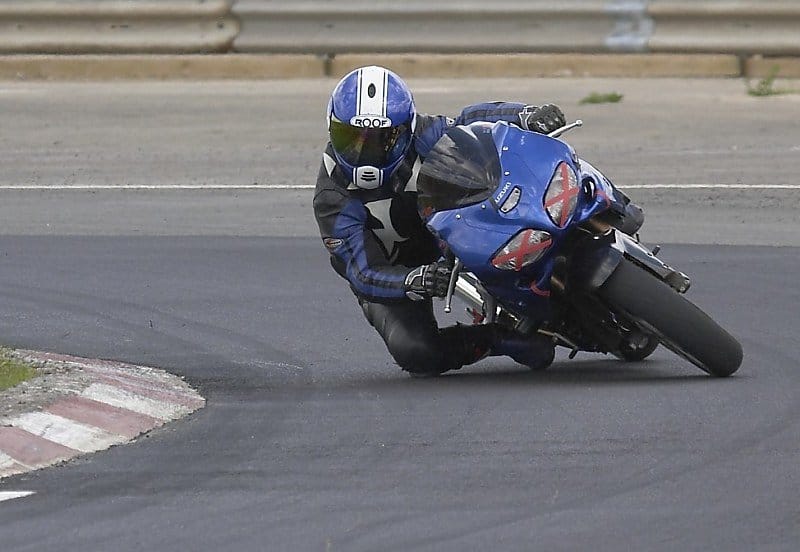Suspension: Measuring & Making Changes

I had a gentleman write in with an interesting question. He is racing an SV 650 and asked how to “measure and dial in rake and swingarm angle”. These two quantities although being very important to the character of a motorcycle are very difficult to measure. The easiest way would be to crate up your bike and ship it to a chassis measuring service such as GMD Computrack. They have several machines in circulation around the US, from Atlanta to Chicago, but there aren’t any in Canada that I am currently aware of. GMD will set your bike on a platform and pick up several key reference points such as the steering head, bottom of the forks, several rim references, swingarm pivot, and axles. They then use a laser measuring device to plot the points. These points are then fed into their proprietary software and a printout is issued. On the printout is information such as rake, trail, swingarm angle, and most specifically information on the chassis’ alignment. In doing the measuring, they will also advise if your motorcycle is indeed straight. With almost every motorcycle, even brand new, right out of the crate, the GMD machine will usually identify a misalignment in the frame or swingarm.
I apologize, I am getting away from the initial question a bit. I guess the point I am making is that the rake and swingarm angle are very difficult to measure for the layperson. The factory sets these numbers into the design of each new chassis and delivers it to you, the rider. The first time you hop on and the bike takes your sag, you are straying from those factory-designated numbers. If you add a couple turns of rear preload, you have increased the swingarm angle and steepened the rake. If you change the rear tire and it has a higher profile, the rake is changed. Rather than worrying what these numbers are or should be, you need to concern yourself with getting the motorcycle to handle safely for you. One of the most important challenges at the racetrack for the beginner is getting the motorcycle to handle the way they want it and keep it handling that way over the course of the season from track to track. The way to do that is to select proper springs for the front and back of the bike, and then set the sags properly. With these baselines established and maintained, the bike will now be consistent. You can then adjust the ride heights front and back to tune the chassis response and grip level until it is safe, predictable, and where you like it. Then if you vigorously keep an eye on your sags, you have isolated any changes you are going to make. You can then learn how changes to the ride heights affect the feeling of the bike without confusion. We check sag constantly, perhaps 5 or 6 times a day per bike. Something as simple as a gearing change can lengthen the effective swingarm, which increases the leverage on the link and shock. This will noticeably affect the sag.
I have drastically oversimplified what takes years to experience, but that is basically the formula to start learning the ins and outs of chassis tuning. There are hundreds of variables such as the one I mentioned above which you will come across as you progress, but that’s what make the challenge rewarding. So, forget about rake and swingarm angle and work with the things you can measure like ride height and sag. Get a notebook and fill it up, especially when you find a set up that really works good, now when you stray, you have the directions to get back.
Another question I had was from a fellow that has a Yamaha TT 225. His question reads: “The fork seems way too soft. I have not changed fork oil in 2 yrs. …Is there certain grade of oil that will help? Do I need to change the springs? Do I add air?” This bike is aimed squarely at the beginner, but is a very competent bike as the rider progresses. That bike is targeted at the beginner and is set up soft for a newer or smaller rider. Lower speeds and/or lighter weight need softer suspension settings to be comfortable. The first thing to determine by being “too soft” is to differentiate between spring rate or damping. A very quick reference to determine if the proper spring is selected is to check the dynamic or ‘rider on’ sag. Getting a friend or two to help, sit on the bike with all your gear on. Without the use of stands, have a friend help you balance the bike with your feet on the pegs, sitting naturally. Bounce on the bike softly several times to ensure the suspension isn’t sticking in a false position (if it is noticeably, you have other problems). The other friend can mark the fork at the dust seal with a sharpie. Now hop off the bike, the two friends can each now grab a handlebar and fully extent the front fork if no shop stand is available to do this. The difference between fully topped up to you on the bike is the dynamic sag. The rule of thumb is 1/3 of full suspension travel, the TT225 has a front stroke of 230mm (approx 9”); therefore your sag should be about 77mm (or 3”). This bike has fairly soft fork springs stock, a progressive spring measuring .35-.4 kg/mm. You have now determined if the fork springs are correct for your weight. I would suspect that your problem is a bit of both. This bike is not adjustable for preload, however earlier versions (94-95) had a Schrader type air fitting to do slight changes of this sort. Perhaps you could backdate the fork caps once you installed some springs that were closer for your particular weight.
If you wish to change the damping on this fork, you are limited to fork oil viscosity changes. Stock is fairly heavy at 10wt, but you could try 15wt if the spring change doesn’t fix the symptoms entirely. The last option to protect the fork from bottoming aggressively if everything else is addressed, is to raise the fork oil level. Stock oil level is 147mm from the top of the tube fully compressed (no spring). The manual will give you a range of adjustment for this level, so raise accordingly. Caution! Especially with heavier oil, do not exceed the maximum recommended fork oil level, or a sudden full compression of the fork can cause a huge pressure spike in the remaining air volume, which could blow the seal with dangerous consequences. If you are still overwhelming this fork after you have exercised all of these options, perhaps you are ready for a bigger bike!
